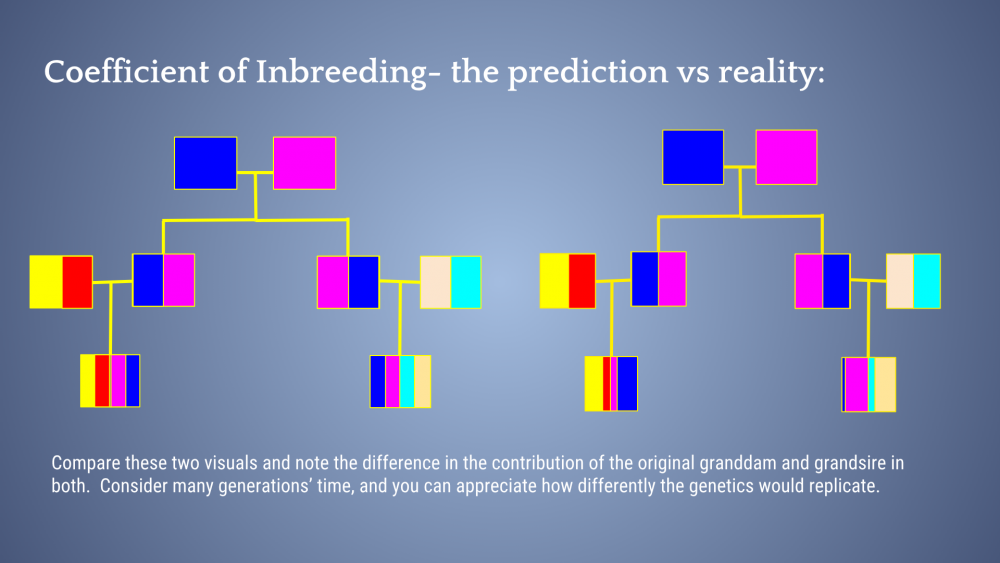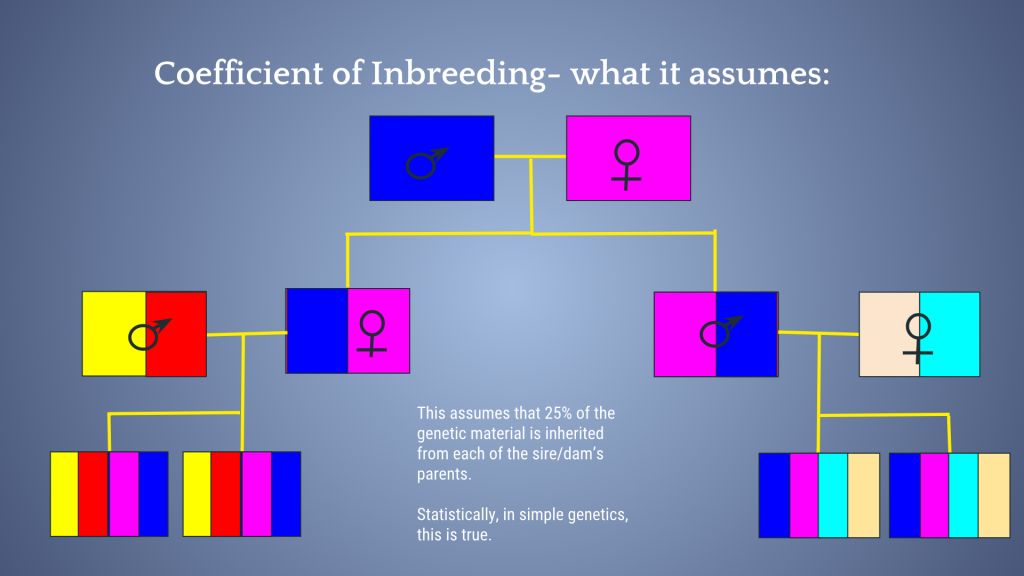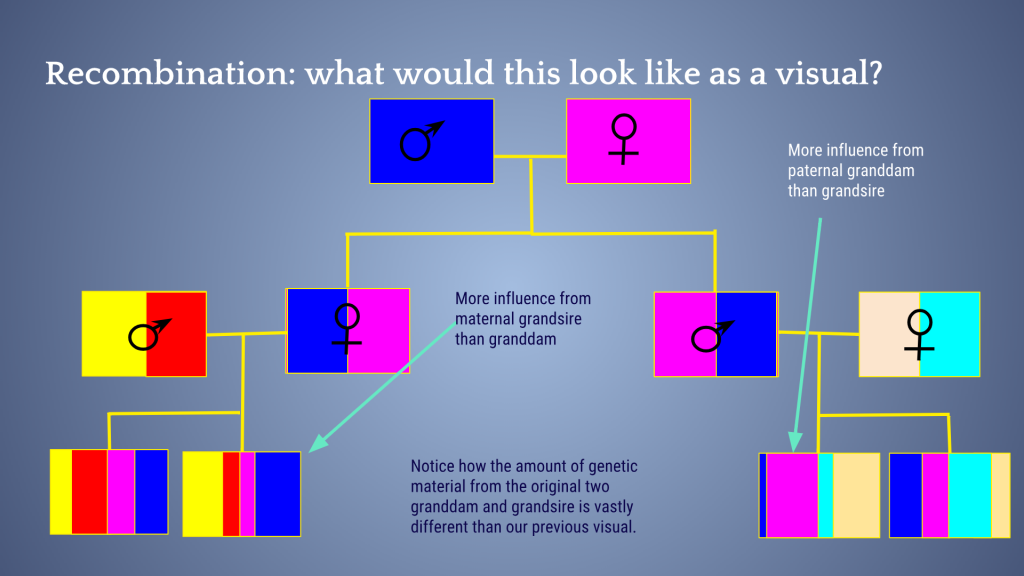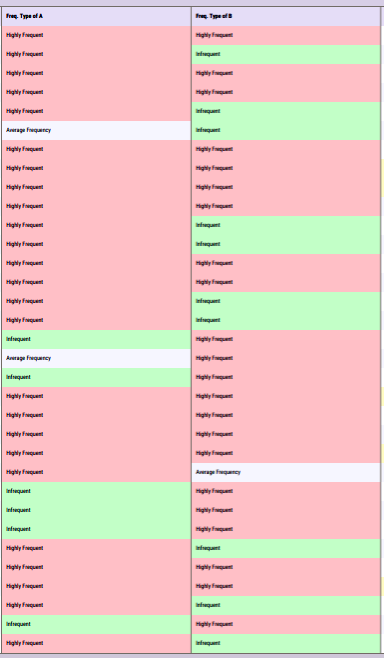
A drop in a bucket: why a complete outcross’ genetics can be lost within one generation
A common conversation I have with breeders is when they tell me there was a Miniature Poodle a couple generations back in their pedigree, therefore they anticipate that their Standard Poodle will come back as atypical in comparison to the Standard Poodle population. (- Of note, Poodles are all one breed, with three varieties. Crossing Miniatures and Standards is uncommon but allowable -.) Frequently, though not always, this is incorrect. This same thing happens in other breeds, when a breeder has tried very hard to find a genetic outcross based on pedigrees. When their test results come back, occasionally people can be very disappointed – the dogs aren’t outbred at all. But why does this happen?

Recombination
One crucial aspect to understand with regard to genetic inheritance is something called recombination. In COI prediction, we believe that the influence of one grandparent is equal to the influence of another grandparent, as seen in the simple illustration to the right. However, the true representation of a grandparent is much different, due to this recombination.
During meiosis, which is the process that create gametes (eggs and sperm), a process called “crossing over” occurs. When this happens, material from one chromosome is exchanged with the other. This is a “reshuffling” of the genetic material received from the sire and dam of a dog (and therefore the genes from their sires and dams). This can happen all along the length of the chromosome, in small or large chunks.

Why do genes reshuffle?
This new combination of genes, may make an animal better suited to adapt to its environment and have better vigor and potential to survive.
This results in a reorganization of the genetic material inherited from one grandparent and another; which creates gametes and then resultant offspring can be very different from one another. So the descendents can also vary greatly, as seen in the image representing first cousins to the left.
The information we will discuss below comes from a dog’s advanced analysis page, which is available to all our full members and gives much more detail about a dog than their individual profile pages.
Let’s look at an actual dog.
The image below shows the genetic makeup of a dog that is the result of a very mainstream bitch of a particular breed bred to an extreme outlier (a dog technically within the breed, but a different variety). This image shows that very few of the alleles are both uncommon, but about 50% of the genetics are “admixed” – meaning half common and half rare genetics. When a dog has a high proportion of admixed ancestry, it often means one parent was very atypical and the other was very typical for the breed.


Next we will take a look at the actual frequency of the alleles on this particular dog’s advanced analysis page (image to the right). All the pink boxes are highly typical, while white are average and green are infrequent. As a result, you can see about 25% of the alleles are “rare”, while 75% of the alleles are average for the breed population. The reason 50% of the genes are not atypical is because the sire is a Miniature Poodle; a breed which does historically share genetic ancestry with Standard Poodles (and is still the same breed, technically).
This dog’s Outlier Index is .39, which is very atypical for this breed, which has a breed average of .24 and has a genetic bottleneck.
The higher the Outlier Index (or OI) the more atypical the dog is for the population and therefore important for avoiding or mitigating a genetic bottleneck. He has some very atypical/infrequent genetics for this breed population, with few at average frequency and a fair amount of typical genetics.
Now, knowing what we know about recombination, this means that those rare genes from this boy’s sire will not necessarily travel together in to his gametes and therefore offspring. So, imagine this dog is bred to a female who is very typical (more pink boxes) for the breed. Looking just at these boxes, one can visualize that if this boy contributes mostly/all pink boxes, or genetic material received from his mainstream dam, resultant offspring will be very typical for this breed population. Therefore, while this dog is himself very atypical for the population, the next generation could be as typical as the mainstream dam, or even more so!
So let’s look at actual offsprings’ alleles and genetics from this “outcross” dog.
The above mentioned dog was indeed bred to a very typical mainstream bitch, and as predicted by our breed management software and by this above discussion, both very typical and atypical puppies resulted from the breeding.
For brevity’s sake, we will post here a couple of the offspring’s genetic diversity results (also from their advanced analysis pages). Here is one offspring who received as many typical genetics as his mainstream dam, much to the surprise of
his owner and breeder when he was genetically tested.

Alternatively, another offspring went the other way, and received a much higher proportion of atypical genetics from the sire and dam, though not as much as the outcross sire himself.

Now taking in to account all we have learned here, you can appreciate how quickly an outcross’s genetics can be lost to a population, much like a drop of dye in a bucket of white paint. Selection just two generations out from a breeding that was similar to crossing two different breeds resulted in genetics just as typical for a population as the mainstream bottlenecked dogs within the breed. This dilution of genetics also demonstrates how systemic inbreeding over time can concentrate genetics and result in a bottleneck.
Of course, stewardship of a breed is about more than genetic diversity, we still must consider type, temperament, health etc during our selection for our keepers. However, preserving our breeds and diversity within them should be an important aspect to consider while planning our breedings and selection for the next generation.
 Previous Post
Previous Post Next Post
Next Post


